Firstly, thanks to Rachael for inviting me to write this post after meeting me at the ECSTATIC conference at Imperial College London, and to her and Anna for creating such a great blog!
My research is all about surfaces. One of the simplest examples of a surface is a sphere. We are all familiar with this – think of a globe or a beach ball. Really we should think of this beach ball as having no thickness at all, in other words it is 2-dimensional. We are allowed to stretch and squeeze it so that it doesn’t look round, but we can’t make every surface in this way. The next distinct surface we come to is the torus. Instead of a beach ball, this is like an inflatable ring (see this post by Rachael). We say that the genus of the torus is 1 because it has one “hole” in it. If we have of these holes then the surface has genus
. The sphere doesn’t have any holes so has genus 0. We can also alter a surface by cutting out a disc. This creates an edge called a boundary component. If we were to try to pass the edge on the surface, we would fall off. Here are a few examples of surfaces.
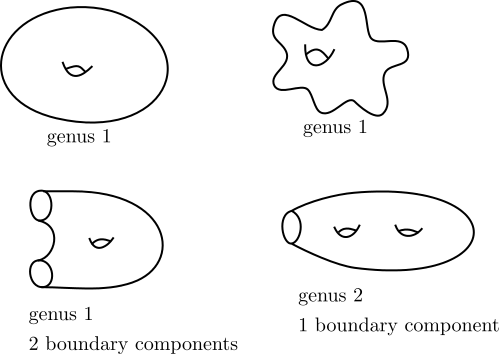
As with the sphere, topology allows us to deform these surfaces in certain ways without them being considered to be different. The classification of surfaces tells us that if two surfaces have the same genus and the same number of boundary components then they are topologically the same, or homeomorphic.
Now that we have a surface, we can start to think about its properties. A recurring theme across mathematics is the idea of symmetries. In topology, the symmetries we have are called self-homeomorphisms. Strictly speaking, all of the self-homeomorphisms we will consider will be orientation-preserving.
Let’s think about some symmetries of the genus 3 surface.
Here is a rotation which has order 2, that is, if we apply it twice, we get back to what we started with.

Here is another order 2 rotation.

And here is a rotation of order 3. Remember that we are allowed to deform the surface so that it looks a bit different to the pictures above but still has genus 3.
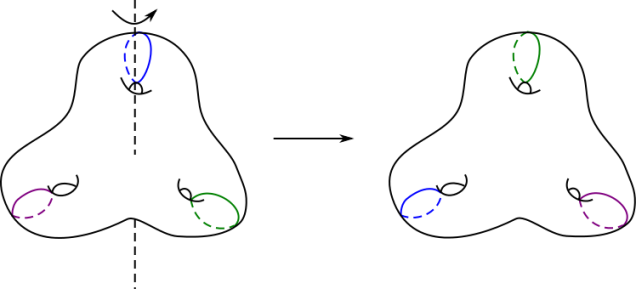
However, not all symmetries of a surface have finite order. Let’s look at a Dehn twist. The picture (for the genus 2 surface) shows the three stages – first we cut along a loop in the surface, then we rotate the part of the surface on just one side of this loop by one full turn, then we stick it back together.

A Dehn twist has infinite order, that is, if we keep on applying it again and again, we never get back to what we started with.
If we compose two homeomorphisms (that is, apply one after the other) then we get another homeomorphism. The self-homeomorphisms also satisfy some other properties which mean that they form a group under composition. However, this group is very big and quite nasty to study, so we usually consider two homeomorphisms to be the same if they are isotopic. This is quite a natural relationship between two homeomorphisms and roughly means that there is a nice continuous way of deforming one into the other. Now we have the set of all isotopy classes of orientation-preserving self-homeomorphisms of the surface, which we call mapping classes. These still form a group under composition – the mapping class group. This group is much nicer. It still (usually) has infinitely many elements, but now we can find a finite list of elements which form a generating set for the group. This means that every element of the group can be made by composing elements from this list. Groups with finite generating sets are often easier to study than groups which don’t have one.
An example of a mapping class group appears in Rachael’s post below. The braid group on strands is the mapping class group of the disc with
punctures (where all homeomorphisms fix the boundary pointwise). Punctures are places where a point is removed from the surface. In some ways punctures are similar to boundary components, where an open disc is removed, but a mapping class can exchange punctures with other punctures.
So how can we study what a mapping class does? Rachael described in her post how we can study the braid group by looking at arcs on the punctured disc. Similarly, in the pictures above of examples of self-homeomorphisms the effect of the homeomorphism is indicated by a few coloured curves. More precisely, these are simple closed curves, which means they are loops which join up without any self-intersections. Suppose we are given a mapping class for a surface but not told which one it is. If we are told that it takes a certain curve to a certain other curve then we can start to narrow it down. If we get information about other curves we can narrow it down even more until eventually we know exactly what the mapping class is.
Now I can tell you a little about what I mainly think about in my research: the curve graph. In topology, a graph consists of a set of points – the vertices – with some pairs of vertices joined by edges.
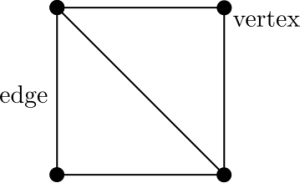
Each vertex in the curve graph represents an isotopy class of curves. As in the case of homeomorphisms, isotopy is a natural relationship between two curves, which more or less corresponds to pushing and pulling a curve into another curve without cutting it open. For example, the two green curves in the picture are isotopic, as are the two blue curves, but green and blue are not isotopic to each other.
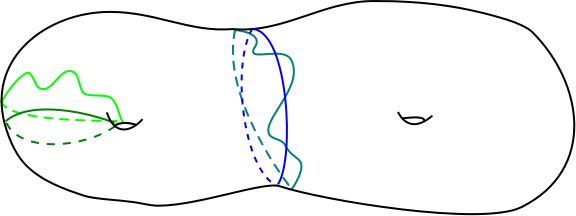
Also, we don’t quite want to use every isotopy class of curves. Curves that can be squashed down to a point (inessential) or into a boundary component (peripheral) don’t tell us very much, so we will ignore them. Here are a few examples of inessential and peripheral curves.
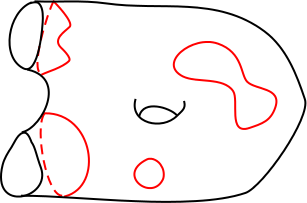
We now have infinitely many vertices, one for every isotopy class of essential, non-peripheral curves, and it is time to add edges. We put an edge between two vertices if they have representative curves which do not intersect. So if two curves from these isotopy classes cross each other we can pull one off the other by an isotopy. Here’s an example of some edges in the curve graph of the genus 2 surface. In the picture, all of the curves are intersecting minimally, so if they intersect here they cannot be isotoped to be disjoint.
I should emphasise that this is only a small subgraph of the curve graph of the genus 2 surface. Not only does the curve graph have infinitely many vertices, but it is also locally infinite – at each vertex, there are infinitely many edges going out! This isn’t too hard to see – if we take any vertex, this represents some curve (up to isotopy). If we cut along this curve we get either one or two smaller surfaces. These contain infinitely many isotopy classes of curves, none of which intersects the original curve.
So why is this graph useful? Well, as we noted above, we can record the effect of a mapping class by what it does to curves. Importantly, the property of whether two curves are disjoint is preserved by a mapping class. So not only does a mapping class take vertices of the curve graph (curves) to vertices, but it preserves whether or not two vertices are connected by an edge. Thus a mapping class gives us a map from the curve graph back to itself, where the vertices may be moved around but, if we ignore the labels, the graph is left looking the same. We say that the mapping class group has an isometric action on the curve graph, so to every element of the group we associate an isometry of the graph, which is a map which preserves distances between elements. The distance between two points in the graph is just the smallest number of edges we need to pass along to get from one to the other. When we have an isometric action of a group on a space, this is really useful for studying the geometry of the group, but that would be another story.

